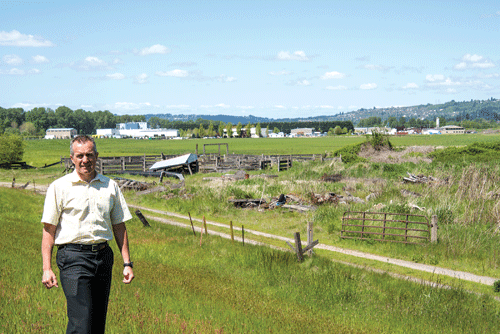“Early in the process, they (the CRC) wanted to break us down and see if we could do part of our work at a satellite facility [west of the bridge],” said Bob Schaefer, an attorney representing TMF. “We went through that [exploratory] process, but ultimately it wasn’t feasible.”
The next phase of mitigation discussions, said Schaefer, involved relocating TMF to the Port of Vancouver. While that scenario is not entirely off the table, Schaefer explained that it’s not very realistic given the CRC’s current budget for mitigation and the complexity of such a move.
“As you look at the cost of relocation, it isn’t a small number,” said Schaefer. “Wherever you go on the river you’re going to have to go through permitting, you’re going to have to bring in rail, road access, utilities, etc.”
Complicating negotiations is a nine-month mitigation study by the CRC that, according to TMF, underestimates the economic damage a 116-foot high bridge (the current proposed height) would cause. Within that study, Schaefer said the CRC factored in company revenues from 2002-2012, but overlooked the enormous growth potential Thompson has forecasted.
“Our clients [in Alaska] anticipate in the next five to six years needing about 15 oil rigs,” he said. “If we get a third of those on the North Slope, that’s five rigs. At $150 to $200 million per rig, that will be a heck of a lot of business for Clark County, I’ll tell you that.”
Coast Guard hosts public meetings
While officials at Thompson await the next phase of negotiations, the company plans to attend and testify at a pair of public meetings hosted by the U.S. Coast Guard next month. The meetings will be held on Tuesday, June 4, from 5 to 8 p.m. at the Red Lion Hotel on the River (909 N Hayden Island Drive, Portland), and on Wednesday, June 5, from 5 to 8 p.m. at the Hilton Vancouver (301 West 6th St.).
The meetings come less than a month after the Coast Guard told CRC staff that it can’t legally proceed with a permit application for a new bridge without more information on the height impact.
“Clearly the Coast Guard is thinking about our right of navigable usage on the river and the law is what it is,” said Thompson CEO John Rudi. “They are doing their job and that is the important part for us.”
The Coast Guard said it hopes to make a decision on the bridge permit application by September 30.
“I think that the CRC needs to get on the ball and start engaging with us more frequently,” added Rudi. “I hope they aren’t waiting to find out what the Coast Guard has to say because by then it would be too late.”
Oregon Iron Works agreement
Unlike TMF, fellow fabricator Oregon Iron Works has made progress in negotiating with the CRC. Earlier this week, the Portland-based company announced it is in the final phases of reaching a mitigation agreement over the impact of the new bridge.
While the details of the agreement were not made public, Schaefer said that because of the type of work they do, Oregon Iron Works doesn’t face the same bridge height restrictions as TMF.
Despite that fact, Rudi said the agreement between the CRC and the nearby fabricator is encouraging.
“I think it’s a good sign that they are serious and recognize that they need to reach agreements with the parties involved,” he said.








